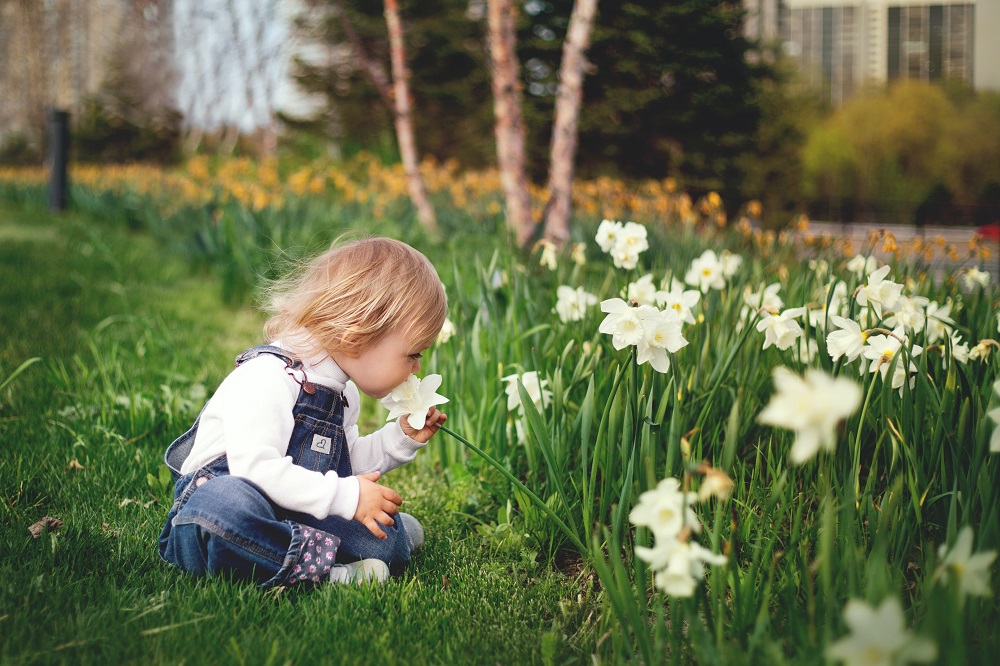Weeds are a problem for healthy living plants but, a huge problem arises when the weed killer accidentally drifts onto your desirable plant. The drift can damage or kill the plants, causing more issues than just weed problems. The time, labor, the money you invested can be lost before you could say, Jack Robinson. This begs the question of what kills weeds, but not flowers.
A selective herbicide is what kills the weeds and not the flowers. You run a risk of killing the weeds with the flowers if you use a contact herbicide. Using a selective herbicide does not mean you spray haphazardly. But, your mind is at rest that your desirable plants are safe if the spray inadvertently drifts onto them.
What is selective herbicide?
A selective herbicide is a post-emergent herbicide that targets specific plants or grasses and does not affect other plants. That makes it practical to eliminate weeds growing around desirable flowers without harming the flowers. The selective herbicide will not damage the desirable plants, flower beds, or lawn even if it accidentally drifts onto them.
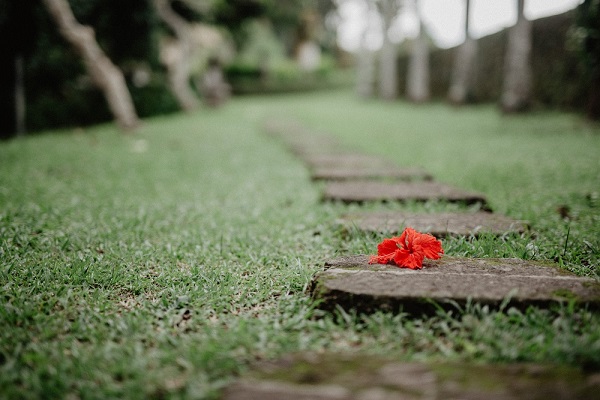
However, there is no universal, selective herbicide; selective herbicides are formulated differently to target certain weeds. For instance, the Ortho garden grass and weed killer is formulated with ingredients that can kill Bermuda grasses, crabgrasses, annuals, and perennials without harming the ornamental plants.
It guarantees safety for shrubs, flowers, and ground covers. Try not to use this herbicide around plants not listed. If the herbicide accidentally drifts onto them, quickly wash off with water.
Therefore, you have to check out two things before buying a selective herbicide. Check if the herbicide can kill the kind of weeds growing around the flowers. And then check if your flowers are tolerant to the herbicide so that if it accidentally drifts onto them, it won’t damage them.
Contact herbicide
Contact herbicide is also a post-emergent herbicide, also called non-selective herbicide. Unlike selective herbicide, contact herbicide kills everything in its way, both the good plants and the unwanted plants.
When using a broad-spectrum herbicide, you want to make sure the herbicide does not drift onto the healthy living plants. Otherwise, it will damage them. You can, however, use contact herbicide around flower beds. You need to apply it with utmost caution nevertheless, so it kills the weeds but not flowers.

Tips on how to use contact herbicide to kill weeds but not flowers
Non-selective herbicides are toxic to all plants, but you can use them safely around your flower bed by following the simple steps below:
- Target the weeds with little to no overspray. The wand-style sprayer can help with this.
- Spray the entire exposed weeds.
- If the weeds are too close to the flowering beds, shield the spray with a piece of cardboard, plastic sheeting, or overturned bucket. This will prevent the chemical from drifting onto the flowers.
- Apply the herbicide in the morning when you have a calm air
- Don’t spray when expecting rainfall or during windy weather.
- Spray around the base of the plants and do not let the herbicide contact the foliage of the desirable plants.
What are post-emergent herbicides?
Post-emergent herbicides are herbicides you apply to fully grown weeds. There are two categories of post-emergent herbicides, they, include selective herbicides and non-selective herbicides. The selective herbicides target just the weeds and kill them. The non-selective herbicide kills everything it contacts, including the good and bad plants.

What are pre-emergent herbicides?
Pre-emergent herbicides are weed preventing herbicides. These kinds of herbicides stop the emergence of weeds in your garden. They are different from the post-emergent herbicides, which are effective for killing sprouted weeds. You apply a pre-emergent herbicide on the bare ground before the weeds begin to grow.
How does pre-emerging herbicide works? After applying the pre-emergent herbicide to the soil, the herbicide gets into the ground and stops any chance of weed growth. Some gardeners have no success with this because it does not work for all weeds. But it is effective for annual weeds and most species of summer and winter weeds.
How to choose the right weed killer for your garden?
When shopping for a herbicide to keep your flower garden healthy and good-looking, you have an idea of the kind of herbicide to buy. Selective herbicides or non-selective herbicides will help kill weeds around your flower beds.
However, you have to use non-selective herbicides with extreme caution. Try as much as possible to prevent it from accidentally contacting your desirable flowers and harming them.
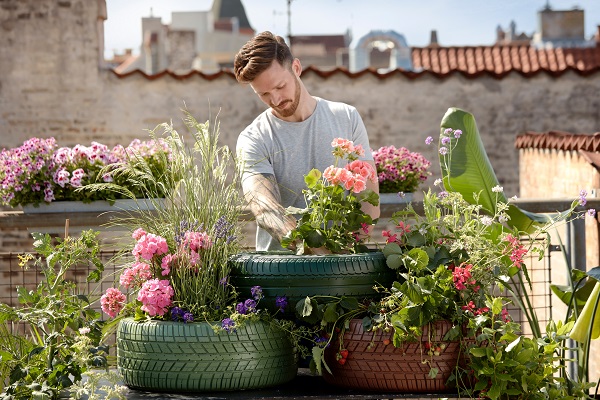
Though selective herbicides will spare your ornamental plants, getting the right one for your weeds and plants matters a lot. That means checking the label or reading the product descriptions to buy the ideal, non-selective weed killer for your weeds and plant.
With non-selective herbicides, it does not require a hassle to buy one, but you have to deal with its drawback. Pre-emergent herbicides are applied to help prevent weed growth. After killing the weeds, you can spray a pre-emergent herbicide to stop their emergence.
Other methods of killing weeds without harming the flowers
Pull them out by hand
This method may seem primitive, but it is the safest and effective method to remove a few weeds in your flower bed without hurting the flower beds. However, using hands to pull weeds is impractical for removing tall and large weeds.
It is to control small weeds with this method. Weed by hand put you in total control of the weed removal. With that, you can uproot just the weeds, but not flowers.

Hand pulling of weeds can be a form of exercise, and you can include it in your routine weeding duties in the garden. The hand removal method is an effective and eco-friendly solution for small gardens or little weeds infestation problems.
Using a weeding tool
Another effective method to get rid of weeds and not hurt the flowers is to use a suitable weeding tool. Weeding tools such as stand-up weeders can help remove weeds with taproots such as dandelion or crabgrass.
They are easy to use: the stand-up weeder allows you to stand upright over the weed or grass you want to remove. Then thrust the tool to the ground, tilt it and extract the weed. You can’t go wrong with this weeder. You can’t accidentally pull the flowers with the weeds.
For younger weeds, you can consider a winged weeder. The hula hoe comes in handy for weeds with a shallow root. These weeding tools are durable. They provide better grip and quick operation. And since they are long-handled, you can use them without hurting your back.
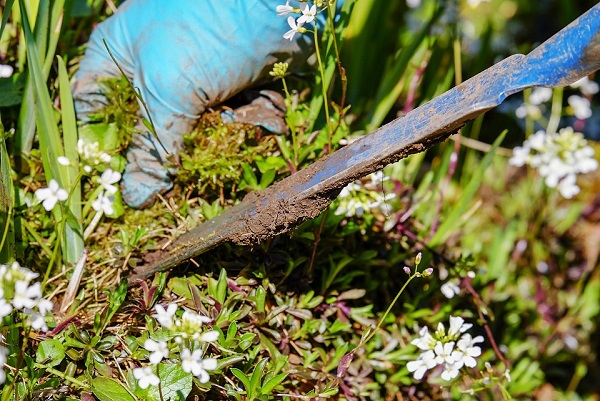
Short-handled tools like the Edward Tools Weeding Tools can also help remove weeds from your garden. The short-handled tools give you better control to remove just the weeds and without harming the flowers.
Vinegar
Vinegar is an effective and natural gardening solution to kill weeds. However, vinegar is not selective. It can’t differentiate between healthy living flowers and weeds. Vinegar kills everything in its path, including the weeds and the desirable.
That said, if you apply caution around the flower beds, vinegar can help destroy the weeds without harming the flowers. Moreover, it is a safer alternative to harsh chemicals.
How to use vinegar as a weed killer?
- Dilate the vinegar: Mix 1 part vinegar with four parts water in a spray bottle.
- Spray it over the unwanted plants.
- Avoid misdirecting the spray.
- Try to do this in the morning in the absence of rain and wind. That will help prevent it from spreading to your flowers. When the sun sets, the vinegar weeding killing properties will activate.
- Use cardboard, plastic sheeting, or a box to shield the spray if your ornamental plants are close to your weeds.
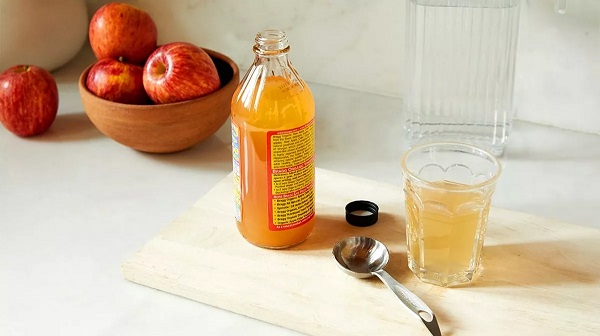
Instead of preparing a vinegar weed killer at home, you can buy the ready-made industrial-grade vinegar weed and grass killer. We recommend the Green Gobbler 20% Vinegar Weed & Grass Killer.
It contains 20% acetic acid, free of glyphosate and harmful chemicals like fluorine, sulfates, or phosphates.
It is ready to use out of the container. It is made from corn grain-derived ethanol, OMRI-listed weed killer, and certified for organic use. Also, the product has a 30-day money-back guarantee. You can apply it around flower beds, farmlands, driveways, and sidewalks.
Boiling water
You can kill weeds but not flowers by simply pouring boiling water over the weeds or grasses and not the flowers. Boiling water is also not selective, so make sure you apply it only on the weeds and not the weeds. Cover the ornamental plants with cardboard, plastic sheeting, or a box if they are close to the weeds.
Conclusion
Removing weeds is vital for the healthy growth of your plant, but deal with it cautiously to avoid hurting your flowers with the weeds.
Your best bet to killing weeds but not flowers is to use selective herbicide. A contact herbicide or non-selective herbicide kills everything in its path. You can still use a contact herbicide around ornamental plants, but you have to use it with extreme caution.
Better still, you can get rid of the weeds using manual methods. Natural methods like applying vinegar or boiling water over the weed can help kill weeds but not flowers if you apply directly on the weeds.
